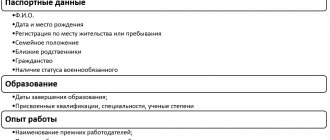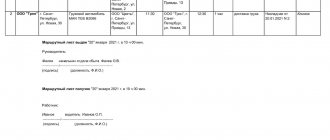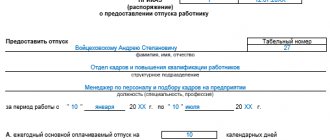According to the “Basic Rules for the Operation of Archives of Organizations”, approved. By the Board of Rosarkhiv dated 02/06/2002, all files of permanent or temporary storage (more than 10 pages) are subject to full registration. This means that the case needs to be hemmed or bound, and also numbered. Then you need to prepare a certification sheet and, if necessary, an internal inventory of the attached documents. The same norm is stipulated in the Rules of Archival Affairs, approved. Ministry of Culture (Order No. 526 of January 31, 2015). For your information, it is these two normative acts that should be relied upon when preparing cases for their subsequent transfer for archiving.
It follows that the preparation of a certification sheet is a mandatory requirement for the complete registration of the case, which is transferred for archival preservation of at least 10 pages. This is an important document that contains mandatory information about the number of numbered sheets of the case, internal inventory, and other nuances of numbering.
The compilation and preparation of the certification sheet is carried out for the most part using the norms and regulations determined by the Rules, approved. By Order of the Ministry of Culture of the Russian Federation No. 526 of March 31, 2015.
Leaf - witness: what is it and what is it “eaten with”
In the course of their activities, every accountant is faced with the fact that at the end of a certain period of time, the entire volume of documents existing in the enterprise must be sorted and filed. This is where elements of office work appear in the work of a specialist. All documents for a particular accounting area are stitched into a file. This allows you to maintain order in documents and monitor their safety in the enterprise.
The certification sheet is drawn up and filled out on the basis of the Archival Rules adopted in 2015 (Appendix No. 8).
The witness sheet allows you to take into account all the features when drawing up the case. With its help, all non-standard moments are fixed when numbering sheets in the case, the nuances of compiling the case itself are indicated .
The certifier sheet must be present in file files for documents whose storage period is more than 10 years.
Case cover design
The case is considered opened after inclusion in the storage folder of the first executed document. At the same time, the cover of the opened case is drawn up. The cover of the case is drawn up in the prescribed form (Appendix 3)
The following information is included on the cover of the case:
Name of the organization;
the name of the structural unit of the organization in which it was formed;
case index according to the nomenclature of cases;
case title;
the shelf life of the file or the inscription “Keep permanently” (transferred from the list of files).
On the cover of permanent storage files, space is provided for the name of the state archive into which the organization’s files will be accepted, designation of the codes of the state archive and organization.
When the name of an organization (structural unit) changes during the period covered by the case documents, or when the case is transferred to another organization (to another structural unit), the new name of this organization or the legal successor organization is indicated on the cover of the case, and the previous name of the organization (structural unit) is enclosed in parentheses.
The title of the case on the cover of the case is transferred from the nomenclature of the organization’s cases, agreed upon with the expert review commission of the relevant archival institution. If necessary, clarifications are included in the title (numbers of orders, protocols, etc.). In cases where the case consists of several volumes (parts), the general title of the case and the title of each volume (part) are placed on the cover of each volume (part). In the headings of cases containing copies of documents, their copy number is indicated; the authenticity of the case documents is not specified in the heading.
After completion of the case, the following information is indicated on its cover:
the number of sheets in the case, which is affixed on the basis of the certification inscription of the case;
date or last dates of the first and last documents in the case;
archival code of the case, first in pencil, and after approval of the inventories - in ink.
If the case includes documents (appendices, etc.), the dates of which go beyond the deadlines of the case, then under the dates of the case, a new line is made about this: “the case contains documents for. year(s)". Case dates may not appear on the cover of files containing annual plans and reports, as they are reflected in the case titles.
The extreme dates of cases containing organizational, administrative, creative and other documentation (protocols, transcripts, letters, reports, etc.), for which precise dating is important, as well as cases consisting of several volumes (parts), are marked with the extreme dates dates of case documents, i.e. dates of registration (drafting) of the earliest and latest documents included in the case.
If the case is a journal of registration of orders, instructions, etc., then the date of the case will be the exact calendar dates of the first and last entries in the journal.
The deadlines for a case containing minutes of meetings are the dates of approval (for documents that are approved) or the drawing up of the first and last minutes constituting the case.
The deadlines for a personal file are the dates of signing the order for the hiring and dismissal of the person for whom the file was opened.
Are you preparing documents for transfer to the archive? Don't forget to draw up a document certifying the case. Fill in the appropriate form with information about the number of sheets and their physical condition. Explain the features of numbering.
From the article you will learn:
Where sheets are usually used - certifiers
In the course of an organization’s activities, a huge number of different documents are created. Some of them are not stored for long and have no particular value, while some are very important and should remain at the disposal of the organization for a long time.
Based on this, it is customary to distinguish 2 types of all documents of the organization:
- Documents that must be kept by the organization for more than 10 years or forever
- Documents that are stored for less than 10 years, that is, temporarily
| Types of documents | Decoding |
| Documents with a storage period of more than 10 years | The documents included in this group are very important for the enterprise. It is important that they can be picked up and looked at at any time. It is these documents that are filed in files and submitted to the archives. In this case, a sheet is drawn up - a witness for the case |
| Documents with a storage period of less than 10 years | Documents of the second group have a relatively short shelf life, so they do not need to be combined into a file, and the sheets do not need to be assigned serial numbers. They may be stored in binders. In this case, the witness sheet is not drawn up |
Expert opinion
Situations often arise when, when transferring cases, it turns out that documents are simply piled up, lying in boxes and no one has sorted them. In such a situation, you need to adhere to the following algorithm:
- We put numbers on the boxes
- We write down the names of documents in boxes
- It is necessary to indicate in what year a particular document was created
- Determining the number of copies of documents
- Next, you need to determine which documents are stored for how long
- Documents for long-term storage are put in order and filed
- We destroy documents whose storage period has expired and draw up an act contained in Appendix 21 to the Archive Rules
This order allows you to quickly and painlessly sort all the documents and put them in order.
Archival specialist
E. Kozhanova
Other requirements for registration of cases transferred for archival storage
Turning again to the methodological basis of the Rosarkhiv Rules, special attention should be paid to some features of the complete registration of permanent (temporary) storage files. This point is important especially in terms of systematization, processing, and grouping of documentation. It is self-evident that the correct approach to this stage of the procedure and compliance with the general requirements for registration simplifies the entire process of preparing cases for their subsequent transfer for storage.
As a standard, documents attached to the case are simply bound or filed in a hard cardboard cover (for 4 protocols). In this case, all pins and other metal fasteners are removed. Unclaimed labor, military IDs, etc. documents are placed in an envelope, and it is filed with the file. If there are many such unclaimed documents, then they are drawn up as an inventory autonomously. Next, in order of priority, at the end of the case being drawn up, a blank certifying sheet is filed, and at the beginning - an internal inventory form, which is also used to record valuable documentation.
Particular attention should be paid to the peculiarities of the numbering of attached documents, which are described in detail in clause 3.6 of the Rules, approved. Rosarkhiv. This point is really important, since the correct arrangement of pages determines the accurate, adequate and complete execution of the entire file, including the certification sheet.
So, according to the requirements of the Federal Archive, all sheets are subject to gross numbering, which is typical, in Arabic numerals. But it does not affect the witness’s form, and the inventory is numbered separately, in a separate order. Volumes and parts are also numbered separately, and on illustrative materials (photos, diagrams, etc.) page numbers are placed at the top, on the reverse side of the sheet.
Each folded sheet (in relation to A3 and A2 formats) is numbered in unfolded form in the upper margin on the right. The sheet on which photos, clippings and other documentation are closely glued should be numbered as one sheet. If documents are glued to the sheet with one edge, then everything must be numbered separately.
And one more nuance that should be taken into account. Envelopes with contents are also numbered separately: first the envelope itself, and then, in turn, all the attachments. Periodicals are often included in the case. As a rule, such documents, especially printed publications, have their own numbering. If it “fits” into the arrangement of sheets, then it is allowed to be saved. If not, then in this publication (another document) numbers are given in the general order.
Varieties of sheet forms - witness
Almost any organization has documents that require the preparation of such sheets. A sheet is drawn up for documents with a shelf life of more than 10 years or those that must be stored permanently.
In total, there are 2 forms according to which this document can be drawn up:
| Document form | Description |
| Unified form | Such a form is approved by law (Order of the Ministry of Culture of the Russian Federation No. 526 of March 31, 2015, Appendix No. 8). This form is mandatory for use in budgetary organizations. |
| A form developed by specialists of a particular enterprise | The document form can be developed by the organization independently, however, all key details must be preserved and such a sheet must contain the specifics of a particular case |
In what place of the case should you attach the sheet - recorder?
As a general rule, the witness sheet must be filed with the case file and be its last sheet. So the finished case should look like this:
- Top cover
- Internal inventory
- Case documents
- List – witness
- Bottom cover
If suddenly for some reason the sheet is not supported, it is placed on the top cover, on the inside.
It is also worth noting that if the witness sheet is missing from an already filed case, then it is drawn up anew, the current date of compilation is indicated and it is attached to the first cover on the inside.
|
Are changes (corrections) made to the record sheet?
Various situations arise during the storage of documents or during the life of the company.
For example, you needed some document from a filed file. In this case, you can take the original from the file, but leave a copy there.
Or, God forbid, there is a fire or flood in the place where the documents are stored and they will be irretrievably damaged.
And the most obvious example would be this. The work record book of the resigned employee lay in the organization for a long time, then it was sent to the archives. And, suddenly, unexpectedly, they come for work. You have to take it out of the envelope in the case and give it back.
To record all these changes, an act of fact of change is drawn up, corrections and notes are made on the record sheet.
It also happens that in a budgetary institution, during an inspection by a higher authority, it becomes necessary to add a sheet to the filed file. In this case, you need to assign a letter number to the new sheet, expand the file and add a sheet to it. Accordingly, corrections are made to the witness sheet and the internal inventory is changed.
An employee’s personal file - how to formalize it correctly
The personal file of an employee in an economic entity is formed for him after the person starts working and contains the most complete information about him, his education, experience and length of service, as well as personal information. The legislation does not require its mandatory maintenance in ordinary companies; the situation is different in public sector organizations. Employees' personal files are kept in the HR department.
Why is a personal file kept?
The management of personal files of employees is entrusted to the personnel department specialists at the enterprise.
Employees' personal files are essentially a binder of copies and originals of documents, orders, statements and other similar forms submitted by the employee.
The file with the case opens after issuing an order to hire an employee and closes after issuing an order to dismiss.
In the process of making decisions on personnel management, relevant specialists need to obtain information about a specific employee. In this case, the employee’s personal file is considered the most complete source. After all, it contains objective information.
Also, personal files of employees make it possible to provide information about employees in the shortest possible time upon incoming requests from outside.
Important! However, personnel officers should not forget about the protection of personal data, and that the employee must give written consent to the disclosure of such information. Therefore, employees’ personal files must be stored in a place where fixed access to them is organized. And in electronic form, various methods of appropriate protection are used.
Federal and municipal laws oblige specialists of budgetary organizations and institutions to draw up and maintain a personal file for each of their employees and employees. This is necessary to systematize information and documents on the personnel of these institutions, as well as to fulfill the requirements of certain laws.
In private companies
The norms of the Labor Code of the Russian Federation do not provide for the obligation of a company to maintain the personal affairs of those working at the enterprise. But such a need can be determined by higher organizations and owners.
How to fill out a time sheet
When deciding on the management of a personal file, the principle of expediency must be used. In small enterprises, personal files of employees are, as a rule, filed with the management of the company - the director, his deputy, the chief accountant, his deputy.
Due to convenience, most companies draw up a personal file for each of their employees.
Documents for creating a personal file
The exact list of forms included in a personal file is defined only for state and municipal organizations and institutions. For other companies, there is no strict list containing exactly what documents should be in the employee’s personal file. They can also use the existing list for the public sector.
It is advisable to start each personal file with a list of forms included in its composition. Documents included in employees' personal files are divided into several categories.
Documents provided when an employee joins the company:
Documents prepared by the HR department upon admission:
Documents drawn up when an employee carries out labor activities:
- Job description;
- Documents on certification or advanced training of the employee;
- Consent to PD processing;
- Application for deductions;
- Leave applications;
- Copies of orders on their provision, orders on encouragement, recovery, transfer;
- Certificates of subsequent medical examinations;
- Reports and explanatory notes regarding this employee;
- Copies of documents on the basis of which changes to personal data are made.
Attention! It is advisable that employees’ personal files contain their photographs, which are updated in a timely manner.
Title page in Word format.
Sample cover in Word format.
An example of an internal document inventory, in Word format.
Procedure for registering a personal file
The personal file folder is opened for the employee at the time of his hiring. The very first thing to be filed into it is a personal card, application form, and documents submitted upon admission to the company.
Employee personal card, form T-2
The process of creating a personal file usually includes the following steps:
- Filling out the title page (cover);
- Drawing up a document certifying the case;
- Filling out the internal inventory;
- Filing or binding of case documents.
Title page
At the top of the title page, the name of the company is written, as well as the designation of the department in which the employee works. The case number and the current number of sheets in the inventory are written large in the right corner.
Full name and full name are entered in the middle of the sheet. employee. It is allowed to record variations of the surname here (for example, the maiden name of a married woman).
At the bottom of the title page are the start and end dates of the register, the total number of sheets collected in it, and the nominal shelf life.
When transferring a case for storage to the archive, a number is indicated in the free space in accordance with the nomenclature accepted in the archive.
Certification sheet
This document is drawn up on a separate A4 or A5 sheet. It is prohibited to place it on the back cover or a blank back on the last sheet of the case document. If the case is stitched without a certification sheet, then it is glued to the top of the cover from the inside.
The certification sheet is intended to indicate the numbering of documents in the file, the physical condition of the sheets, the specifics of filling out individual forms, etc.
In particular, it is noted here:
- Letter numbers of sheets;
- Missing page numbering;
- Sheets with photographs;
- Sewn-in large-format sheets;
- Envelopes with hemmed attachments in them;
- Damaged sheets
Attention! The certifying sheet is signed by the compiler, after which he puts the date of execution and a transcript of the signature.
The inventory indicates the case number and its title (usually this is the employee’s full name).
The tabular part of the document consistently indicates information about new forms added to the file. The serial number, document index (if available), name, and number of sheets in the new document are entered here.
At the end of the list, the total number of documents filed, as well as the number of pages in the inventory, is written down in words and numbers.
Finally, the document is signed by a personnel specialist, with the full name deciphered. and indicating the date of registration.
Internal inventory of case documents
Such an inventory is a kind of content of the case. It indicates the number, date, numbers of sheets of documents .
To properly file a case, you first need to create an internal inventory of documents. This is a tedious and tedious task. Often, organizations do not fill out such a document.
However, for documents that are stored for 10 years or permanently and for some documents (for example, court documents), the preparation of such an inventory is mandatory. If, for example, personnel documents are filed, then drawing up an inventory is advisable. Indeed, in case of trouble, the inventory can confirm or deny the presence of a particular document.
The inventory form is fixed and unified.
When compiling the inventory, we pay attention to filling out the required fields of the form and to the signature of the employee who filled it out.
If you suddenly forgot to file the inventory, you can attach it to the inside of the top cover of the bound file.
Formation of personal files of employees
Formation of cases is the grouping of executed documents into a case in accordance with the nomenclature of cases and their systematization within the case.
The HR department employee forms the files.
Rules for forming cases
Documents are placed in the case in strict accordance with the nomenclature of cases approved by the company. When forming cases, you need to follow several rules:
- Only executed documents on which the work has been completed are placed in the file. It is prohibited to file documents that have not been executed or that must be returned to the file;
- Only the original documents are filed, and for outgoing documents - their second copies, certified by the signature of an authorized employee;
- drafts and versions of documents that are not signed or approved by the manager are prohibited from being filed;
- documents placed in the file must have registration numbers, internal page numbering, information about the performers, their signatures;
- the type of document and its content must correspond to the title of the case according to the nomenclature to which this document relates;
- documents within the case are arranged in chronological or numerical sequence;
- only one copy of the document is included in the file;
- documents with different retention periods are formed into separate files;
- documents on one issue are placed in one file;
- documents of permanent and temporary storage are grouped into separate files;
- documents executed within one calendar year are combined into the case. The exception is transitional, judicial and personal cases;
- the file should not contain more than 250 sheets. If the number of documents on one issue exceeds 250 sheets, the case is divided into volumes.
Filing of cases is a complex of works on the technical processing of cases: drawing up an internal inventory and certification, filing (binding) of the case, designing the cover.
Depending on the storage period, cases are subject to full or partial registration.
Cases of temporary (up to 10 years inclusive) storage are partially completed:
- they are not filed, but stored in binders;
- It is allowed not to number the sheets and not to file the sheet - the witness of the case.
Permanent and long-term (over 10 years) storage records require full registration. When fully completed, it is necessary to file or bind the files into a hard cover, number the sheets in the file, draw up a certification note and an internal list of documents.
To bind a case, four punctures must be made in the documents placed in it. The holes are pierced with an awl, a hand drill or a special hole punch. The documents are then stitched with strong thread and placed in a hard cover.
The text of the document cannot be stitched. If the text is very close to the edge of the sheet and can be damaged during filing, glue a strip of strong paper to the sheet, and use it to file the document.
The sheets in the file are numbered in pencil in the upper right corner. All sheets must be numbered, except for the internal inventory sheets and the sheet with the certification inscription. The internal inventory sheets are numbered separately. To correct a numbering error, just cross out the old number and put the new one next to it.
If a missing number is detected, you need to put an additional one next to it (it’s called a letter number). It consists of the number of the previous sheet and a letter, for example: 12a, 12b. Information about all changes in numbering is entered into the sheet - the witness of the case. The total number of sheets in the case is indicated on the cover.
The cover of the case is designed like this:
- in the top field indicate the full name of the company (if there is an official abbreviated name, it is placed in brackets) and the name of the structural unit;
- then write the serial number of the case according to the inventory (archive code);
- The case index and document storage period are transferred to the cover from the case nomenclature. The shelf life is indicated in the lower right corner of the cover. On files with a permanent shelf life they write: “keep permanently”;
- The dates of the case are also indicated in the lower right corner of the cover. They usually coincide with the deadlines for the case documents. For example, the dates of a case containing administrative documents (orders, instructions, etc.) are considered to be the date (day, month, year of registration or compilation) of the earliest document and the date of the latest document included in the case. The dates of the personal file are the date of signing the order to hire and the date of signing the order to dismiss the employee.
If documents contain confidential information, the cover must be marked “For Official Use,” “Secret,” or “Confidential.”
The internal inventory contains information about the titles of the documents that are placed in the file and the numbers of the sheets on which each document is located.
When compiling an inventory, the following rules must be observed:
- the headings of cases are entered into the inventory, strictly adhering to the systematization established in the nomenclature of cases;
- each case is assigned an independent number, and if it consists of several volumes, then each volume is assigned a separate number;
- the information in the inventory columns must exactly match the information on the cover of the case;
- When adding cases with the same headings to the inventory, only the title of the first case is written in full, and the rest are designated with the words “same.” Other information about these cases is given in full;
- In the “Note” column, notes are made about the acceptance of cases, their transfer to other departments, etc.
Based on the internal inventory, an annual section of the consolidated inventory of the company’s affairs is compiled. Usually, its preparation is carried out by the archive of the organization under the direct methodological guidance of the archival institution.
Here is a sample of filling out the internal inventory:
At the end of each case, a certification inscription is made on a separate sheet (sheet - the witness of the case). It takes into account the number of sheets of the case and records information about all changes in the composition and status of the case (for example, the addition of new documents).
The compiler must sign it, indicate his position and the date of compilation.
Here is an example of the design of a sheet - a witness of the case:
Storage organization
Personnel documents filed in files must be stored in specially equipped rooms with constant temperature conditions and a sufficient number of storage spaces (locked cabinets, safes).
To work with documents, normal conditions must be created in the storage room: the room is equipped with desks, chairs, and table lamps. Access to storage areas must not be obstructed by furniture.
Only HR department employees responsible for storing documents and the head of the HR department can have access to the storage facility. During the working day, the keys to cabinets and safes are kept by the employee responsible for storage. At the end of the working day, he is obliged to hand them over to the security officer on duty against signature.
To speed up the search for documents, it is advisable to arrange files, strictly observing the order of the indexes provided for in the nomenclature of cases. Indexes can be written on the spines of case covers. A copy of the list of cases must be placed on the inside of the cabinet (safe) door.
The procedure for working with documents in storage can be specified in special instructions. It defines:
- how, for what period and at what time (days of the week, hours) documents can be issued;
- where to work with them;
- how to copy them;
- how to make statements, etc.
The instructions are developed by the HR department, and are certified by its boss and the head of the company.
Regulatory regulation of document preparation
| Event | Normative act |
| Form of the certificate sheet | Order of the Ministry of Culture of Russia No. 526 of March 31, 2015 |
| Documentation requirements | GOST R 7.0.8-2013, approved and put into effect by Order of Rosstandart No. 1185-st dated October 17, 2013 |
| List of standard documents used by construction, scientific or industrial and technical enterprises | Order of the Ministry of Culture No. 1182 of July 31, 2007 |
| List of unified forms for all other enterprises | Order of the Ministry of Culture of the Russian Federation No. 558 of August 25, 2010 |
| How to prepare and transfer cases to the archive | The procedure developed by Glavgosexpertiza of Russia in 1999 |
Great secretary
The volume of the case ends with the completion of the certification sheet. Where to get its form and how to fill out the case certification sheet, what are the letter numbers and what features of the state of the case should be reflected in it, as well as a sample of the case certification sheet in the article.
You can also download the form here.
The form of the case certification sheet is Appendix No. 8 to.
Let me remind you: they are mandatory for everyone. The form itself is simple. First, we write in numbers and in words how many sheets of the file are filed in that volume. Internal inventory sheets are not counted. Then indicate the numbers of the outer sheets of the case, for example: from No. 1 to No. 204. Then come the letter numbers and the missing ones. Letter numbers are numbers with letters: 10a, 55a, etc.
They are formed if, when numbering the sheets, one was accidentally missed (everyone is human, everyone makes mistakes).
In this case, you don’t need to redo anything, but simply take the previous number and put it on an unnumbered sheet, but with a letter. It will turn out, for example, 54, 55, 55a, 56, 57....
The same goes for the missing ones: you accidentally missed the sheet about numbering - no big deal, just don’t forget to reflect this on the certification sheet. If there are no letters or missing sheets, put dashes in these fields. Then we separately indicate the number of sheets of the internal inventory.
The following is a table about the features of the physical state of the case. In the left column we write what the feature is, in the right - on which sheets. The features may be different: the sheet may be torn, filled with water or something else, the copy may be very pale or, conversely, dark to the point of being readable.
Let's record this. It is recommended to indicate the basic rules for the operation of archives of organizations here:
- numbers of sheets with pasted photographs;
- numbers of large format sheets;
- the presence in the file of printed copies of brochures with the number of sheets in them, if they were not noted during the general numbering of the sheets of the case.
- envelopes with attachments and the number of sheets enclosed in them;
If, fortunately, the case does not have any special features, we cross out this table with the letter Z. The certification sheet is signed by the person who compiled it.
The document certifying the case is filed last.
Thus, a volume of a fully completed case looks like this: a cover with a title page, then -, then the case documents, a certification sheet, a cover. If before you the cases were completed without certifying sheets, then there is no need to open up the volumes for the sake of them. The certification sheet is then pasted behind the top of the sheet on the inside cover of the case.
The 2015 Rules require that all changes in the physical condition or composition of the case be recorded on the certification sheet.
The physical condition does not raise any questions, but can the composition of the stitched case really change? Yes maybe. A striking example is the one we talked about a week ago. Since they can come for them at any time, books about the firmware of the volume are not punctured. The envelopes in which they are enclosed are pierced, with 1 envelope corresponding to one sheet of the case.
If after a few years a person or his relatives request this book, then we issue it in accordance with the general procedure.
Certification sheet for the case (form, sample, download)
Author of the article Victoria Ananina 3 minutes to read 160 views Contents According to, approved. By the Board of Rosarkhiv dated 02/06/2002, all files of permanent or temporary storage (more than 10 pages) are subject to full registration.
This means that the case needs to be hemmed or bound, and also numbered.
Then you need to prepare a certification sheet and, if necessary, an internal inventory of the attached documents. The same norm is stipulated in, approved.
Ministry of Culture (Order No. 526 of January 31, 2015).
For your information, it is these two normative acts that should be relied upon when preparing cases for their subsequent transfer for archival preservation. It follows that the preparation of a certification sheet is a mandatory requirement for the complete registration of a case that is transferred for archival preservation of at least 10 pages.
This is an important document that contains mandatory information about the number of numbered sheets of the case, the internal inventory, and other nuances of numbering. The compilation and preparation of the certification sheet is carried out for the most part using the norms and regulations determined by the Rules, approved. Order of the Ministry of Culture of the Russian Federation No. 526 dated March 31, 2015. So, before transferring the case for preservation, it must be formalized in the generally established manner.
To do this, you will need, among other things, to fill out a certification sheet, indicating the number of sheets of the case, their actual physical condition and the nuances of numbering. It should be noted that we are talking about cases that are executed on paper.
A standard one-page form is provided for the certification sheet. One of its variants, a later one, is presented, and the second -. Both options are almost identical and require entering the same data. Unlike the first, the second form, introduced by order of the Ministry of Culture of the Russian Federation (Appendix.
No. 8), supplemented by one more line. It needs to detail the filed and numbered sheets, i.e.
e. indicate the numbers of the first and last sheet. Otherwise, both the form and the procedure for filling out the form for 2021.
did not undergo any changes and remained the same. Form of the certification sheet Who approved the form, where it can be found App. No. 8 to Order of the Ministry of Culture of the Russian Federation No. 526 of January 31, 2015 Appendix. No. 9 to the Rules, approved. By the decision of the Board of Rosarkhiv dated 02/06/2002, it is considered that the Rules approved by Rosarkhiv are more of a methodological nature, and the Rules, approved.
Order No. 526 of the Ministry of Culture of the Russian Federation is normative. For practical purposes, the latter document has dominant meaning. Accordingly, we will further consider the form of the certification sheet, introduced by a more current order of the Ministry of Culture. To prepare the certification sheet, it is recommended to use a separate sheet of paper in A 4 format (210 x 297 mm), which can be filed after filling out. Its standard form includes standard document details , as well as information related to the case filed for archival storage.
The structure of the form provides for entering the following information: No., name, date of compilation; position held, handwritten signature of the compiler with subsequent decoding; summary
Frequently encountered errors and questions on the topic
Mistake #1.
When compiling cases, there can be many nuances in the numbering of sheets, so if the case has many difficulties in compiling, then it is best to first “sketch out” a draft, and then draw up a sheet - the witness in its final form.
Mistake #2.
It is necessary to file documents in the case. Among the documents that do not raise doubts regarding the assignment of sheet numbers, there are brochures with the last blank sheet. There are also sheets of non-standard format, but only partially filled. Since the cover cannot be torn off from the brochure, and the sheets may not be filled over the entire area, each sheet is numbered in order, without gaps.
How to make a correction to the sheet if an unclaimed work book was issued?
Sometimes it happens that a person quits his job, but does not pick up his work book for some reason. Then the book lies at the enterprise and waits in the wings. When filing documents in the archive, such work books are placed in envelopes and filed.
It happens that such unclaimed books are still taken away, and then corrections have to be made to the witness sheet. In this case, a handwritten inscription is made on the sheet, for example:
“The work book was issued (sheet 24), entry No. 205 was made in the work book movement book.
Archive specialist Sakharova Sakharova L.M.
07/15/2006"
How to make corrections if more than 5 errors were made when numbering the sheets of the case?
Sometimes, for some reason, errors “pop up” when numbering sheets in a filed file. In this case, 2 situations are possible:
– if there are less than 5 errors in the numbering, then the number of such sheets is indicated using letters
– if there are more than 5 errors in the numbering of sheets, then you will have to re-enter the serial numbers of the sheets, and cross out the old incorrect number with one line. At the same time, a new sheet is drawn up - a witness. The old sheet must remain filed in the file.








